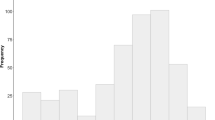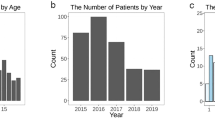Abstract
Background and objectives
Epistaxis is a common emergency for otorhinolaryngologists. Although the aetiological factors have been widely studied, they remain subject to debate. The role of meteorological variables has been discussed in recent years, but results have been inconsistent. Given a lack of prior data, the aim of our study was to identify the meteorological variables that influence the frequency of visits and hospital admission for epistaxis in a city with a cold semi-arid climate in Spain.
Methods
Case–control study. Cases: patients who attended the accident and emergency department of a secondary level hospital for epistaxis over a 9-year period (2011–2019). Controls were established by simple random sampling among emergency rooms visits in general (patients who attended the same centre over the same period of time). Sociodemographic, clinical and meteorological variables were all taken into account.
Results
2749 patients in the epistaxis group and 2764 in the control group. There were significant differences in the epistaxis group, with a higher proportion of male (62.85%) and older patients. Univariate and multivariate analysis revealed that the daily minimum temperature and maximum wind speed were factors significantly associated with the onset of epistaxis. In addition, logistic regression analysis showed that decreases in minimum temperature and increases in maximum wind speed were associated with an increase in epistaxis (p < 0.01). No association was found between hospital admission and the weather conditions.
Conclusion
Our findings suggest that low minimum temperatures and high wind speeds are associated with the number of visits to hospital accident and emergency departments for epistaxis, but not with hospital admission.



Similar content being viewed by others
Data availability
I, [Javier Gómez-Hervás], as the owner of the data related to the study titled “[ Influence of meteorological variables on the frequency of visits and hospital admission for epistaxis in a city with a cold semi-arid climate (Lorca, Spain)],” hereby declare that the following data is available for access and use by other researchers and stakeholders on javiergomezhervas@yahoo.es.
References
Merino-Galvez E, Gomez-Hervas J, Perez-Mestre D, Llamas-Peiro JM, Perez-Gil E, Belda-Palazon M (2019) Epidemiology of otorhinolaryngologic emergencies in a secondary hospital: analysis of 64,054 cases. Eur Arch Otorhinolaryngol 276(3):911–917. https://doi.org/10.1007/s00405-019-05331-w
Bertrand B, Eloy P, Rombaux P, Lamarque C, Watelet JB, Collet S (2005) Guidelines to the management of epistaxis. B-ENT 1(Suppl 1):27–41
Reis LR, Correia F, Castelhano L, Escada P (2018) Epidemiology of epistaxis in the emergency department of a southern European tertiary care hospital. Acta Otorrinolaringol Esp 69(6):331–338. https://doi.org/10.1016/j.otorri.2017.11.002. (English, Spanish)
Monjas-Cánovas I, Hernández-García I, Mauri-Barberá J, Sanz-Romero B, Gras-Albert JR (2010) Epidemiology of epistaxes admitted to a tertiary hospital. Acta Otorrinolaringol Esp 61(1):41–47. https://doi.org/10.1016/j.otorri.2009.09.003. (English, Spanish)
Bray D, Giddings CE, Monnery P, Eze N, Lo S, Toma AG (2005) Epistaxis: are temperature and seasonal variations true factors in incidence? J Laryngol Otol 119(9):724–726. https://doi.org/10.1258/0022215054798032
Jelavic B, Majstorovic Z, Kordić M, Leventić M, Grgić MV, Baudoin T (2015) Idiopathic epistaxis and meteorological factors: case-control study. B-ENT 11(4):267–273
Min SJ, Kang H, Kim KS, Min HJ (2020) Minimal temperature, mean wind speed, and mean relative humidity are associated with spontaneous epistaxis in Seoul, Korea. Auris Nasus Larynx. https://doi.org/10.1016/j.anl.2020.07.012
Peel MC, Finlayson BL, McMahon TA (2007) Updated world map of the Köppen–Geiger climate classification. Hydrol Earth Syst Sci 11:1633–1644. https://doi.org/10.5194/hess-11-1633-2007
Beck HE, Zimmermann NE, McVicar TR, Vergopolan N, Berg A, Wood EF (2018) Present and future Köppen–Geiger climate classification maps at 1-km resolution. Sci Data 30(5):180214. https://doi.org/10.1038/sdata.2018.214
Mangussi-Gomes J, Enout MJ, Castro TC, de Andrade JS, Penido NO, Kosugi EM (2016) Is the occurrence of spontaneous epistaxis related to climatic variables? A retrospective clinical, epidemiological and meteorological study. Acta Otolaryngol 136(11):1184–1189. https://doi.org/10.1080/00016489.2016.1191673. (Epub 2016 Jun 13)
McMullin B, Atkinson P, Larivée N, Chin CJ (2019) Examining seasonal variation in epistaxis in a maritime climate. J Otolaryngol Head Neck Surg 48(1):74. https://doi.org/10.1186/s40463-019-0395-y
Purkey MR, Seeskin Z, Chandra R (2014) Seasonal variation and predictors of epistaxis. Laryngoscope 124(9):2028–2033. https://doi.org/10.1002/lary.24679
Minami K, Haji T (2016) Intranasal topical estrogen in the management of epistaxis in hereditary hemorrhagic telangiectasia. Acta Otolaryngol 136(5):528–531. https://doi.org/10.3109/00016489.2015.1129070
Pallin DJ, Chng YM, McKay MP, Emond JA, Pelletier AJ, Camargo CA Jr (2005) Epidemiology of epistaxis in US emergency departments, 1992 to 2001. Ann Emerg Med 46(1):77–81. https://doi.org/10.1016/j.annemergmed.2004.12.014
Chaaban MR, Zhang D, Resto V, Goodwin JS (2017) Demographic, seasonal, and geographic differences in emergency department visits for epistaxis. Otolaryngol Head Neck Surg 156(1):81–86. https://doi.org/10.1177/0194599816667295
Akdoğan MV, Hızal E, Semiz M, Topal Ö, Akkaş H, Kabataş A, Erbek SS (2018) The role of meteorologic factors and air pollution on the frequency of pediatric epistaxis. Ear Nose Throat J 97(9):E1–E5. https://doi.org/10.1177/014556131809700901
Szyszkowicz M, Shutt R, Kousha T, Rowe BH (2014) Air pollution and emergency department visits for epistaxis. Clin Otolaryngol 39(6):345–351. https://doi.org/10.1111/coa.12296
Jindal G, Gemmete J, Gandhi D (2012) Interventional neuroradiology applications in otolaryngology, head and neck surgery. Otolaryngol Clin N Am 45(6):1423–1449. https://doi.org/10.1016/j.otc.2012.08.010
Cooper SE, Ramakrishnan VR (2012) Direct cauterization of the nasal septal artery for epistaxis. Laryngoscope 122(4):738–740. https://doi.org/10.1002/lary.23225
Comelli I, Vincenti V, Benatti M, Macri GF, Comelli D, Lippi G, Cervellin G (2015) Influence of air temperature variations on incidence of epistaxis. Am J Rhinol Allergy 29(6):e175–e181. https://doi.org/10.2500/ajra.2015.29.4239
Zhang S, Ban M, Wang R, Li F, Qu S, Lu Q (2021) Exploration of the correlation between allergic rhinitis and weather factors in Nanning. Lin Chung Er Bi Yan Hou Tou Jing Wai Ke Za Zhi 35(1):1–8. https://doi.org/10.13201/j.issn.2096-7993.2021.01.001. (Chinese)
Sowerby LJ, DeSerres JJ, Rudmik L, Wright ED (2014) Role of season, temperature and humidity on the incidence of epistaxis in Alberta, Canada. J Otolaryngol Head Neck Surg 43(1):10. https://doi.org/10.1186/1916-0216-43-10
Liu DT, Besser G, Parzefall T, Riss D, Mueller CA (2020) Winter peaks in web-based public inquiry into epistaxis. Eur Arch Otorhinolaryngol 277(7):1977–1985. https://doi.org/10.1007/s00405-020-05915-x
Yu G, Fu Y, Dong C, Duan H, Li H (2018) Is the occurrence of pediatric epistaxis related to climatic variables? Int J Pediatr Otorhinolaryngol 113:182–187. https://doi.org/10.1016/j.ijporl.2018.07.053. (Epub 2018 Jul 31)
Kemal O, Sen E (2014) Does the weather really affect epistaxis? B-ENT 10(3):199–202
Shay S, Shapiro NL, Bhattacharyya N (2017) Epidemiological characteristics of pediatric epistaxis presenting to the emergency department. Int J Pediatr Otorhinolaryngol 103:121–124. https://doi.org/10.1016/j.ijporl.2017.10.026
Cruz AA, Naclerio RM, Proud D, Togias A (2006) Epithelial shedding is associated with nasal reactions to cold, dry air. J Allergy Clin Immunol 117(6):1351–1358. https://doi.org/10.1016/j.jaci.2006.01.054
Cruz AA, Togias A (2008) Upper airways reactions to cold air. Curr Allergy Asthma Rep 8(2):111–117. https://doi.org/10.1007/s11882-008-0020-z
Tunkel DE, Anne S, Payne SC, Ishman SL, Rosenfeld RM, Abramson PJ, Alikhaani JD, Benoit MM, Bercovitz RS, Brown MD, Chernobilsky B, Feldstein DA, Hackell JM, Holbrook EH, Holdsworth SM, Lin KW, Lind MM, Poetker DM, Riley CA, Schneider JS, Seidman MD, Vadlamudi V, Valdez TA, Nnacheta LC, Monjur TM (2020) Clinical practice guideline: nosebleed (epistaxis) executive summary. Otolaryngol Head Neck Surg 162(1):8–25. https://doi.org/10.1177/0194599819889955
Csavina J, Field J, Félix O, Corral-Avitia AY, Sáez AE, Betterton EA (2014) Effect of wind speed and relative humidity on atmospheric dust concentrations in semi-arid climates. Sci Total Environ 15(487):82–90. https://doi.org/10.1016/j.scitotenv.2014.03.138
Funding
This study did not receive any funding.
Author information
Authors and Affiliations
Corresponding author
Ethics declarations
Conflict of interest
All the authors declare that they have no conflicts of interest.
Ethical considerations
This study was approved by the ethics committee of Hospital Rafael Méndez.
Additional information
Publisher's Note
Springer Nature remains neutral with regard to jurisdictional claims in published maps and institutional affiliations.
Rights and permissions
Springer Nature or its licensor (e.g. a society or other partner) holds exclusive rights to this article under a publishing agreement with the author(s) or other rightsholder(s); author self-archiving of the accepted manuscript version of this article is solely governed by the terms of such publishing agreement and applicable law.
About this article
Cite this article
Gómez-Hervás, J., Merino-Galvez, E. Influence of meteorological variables on the frequency of visits and hospital admission for epistaxis in a city with a cold semi-arid climate (Lorca, Spain). Eur Arch Otorhinolaryngol 281, 1307–1315 (2024). https://doi.org/10.1007/s00405-023-08300-6
Received:
Accepted:
Published:
Issue Date:
DOI: https://doi.org/10.1007/s00405-023-08300-6




